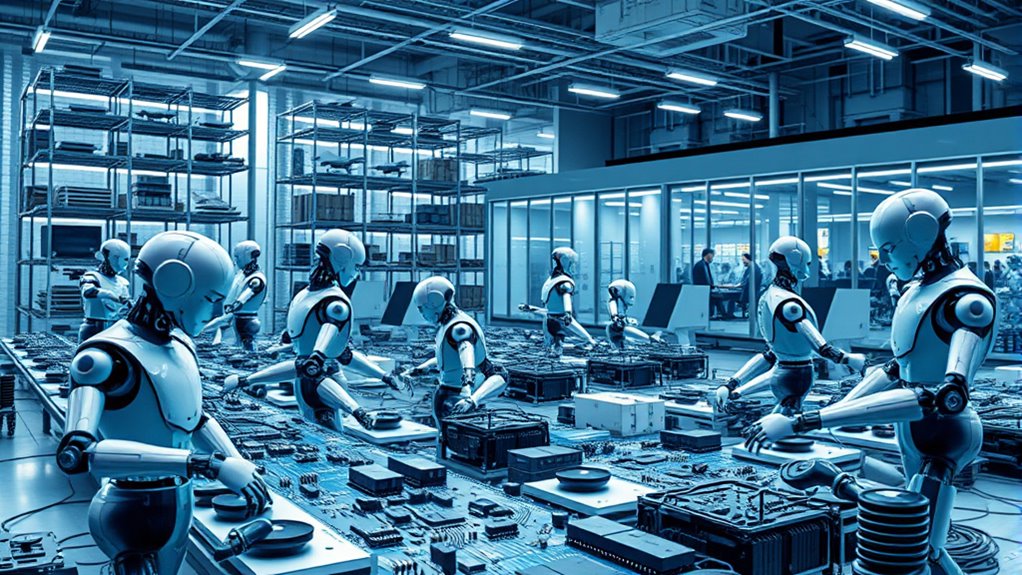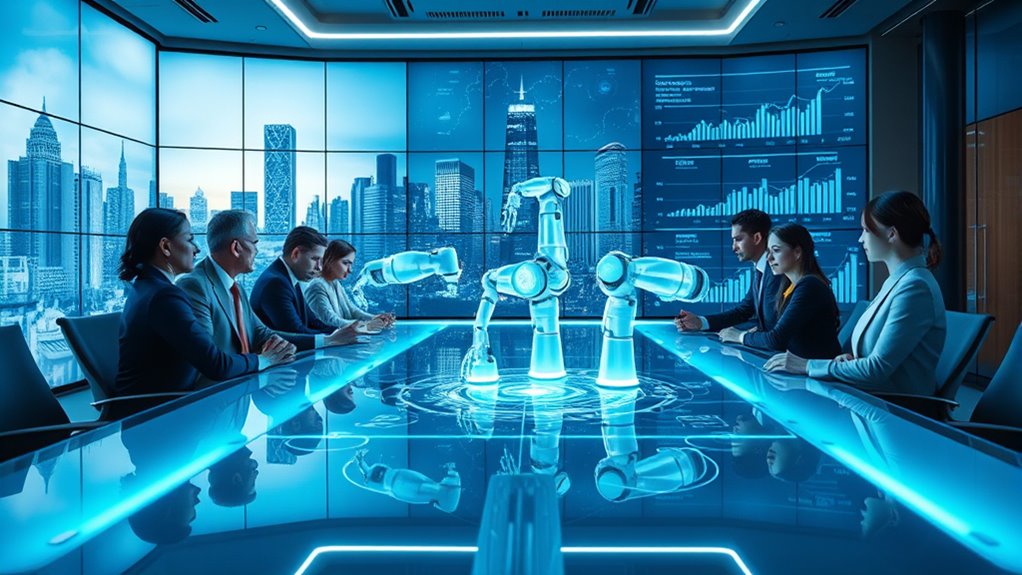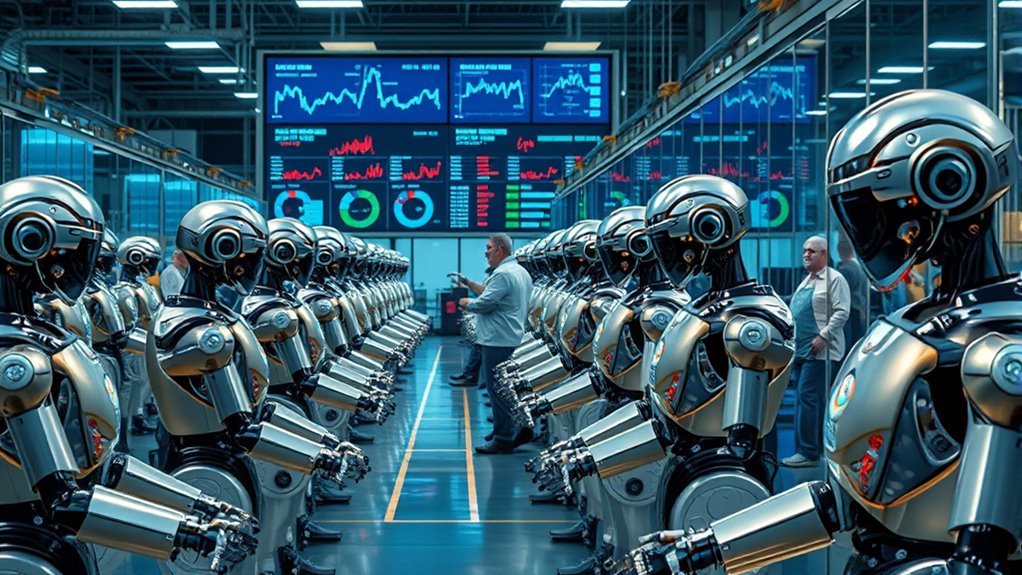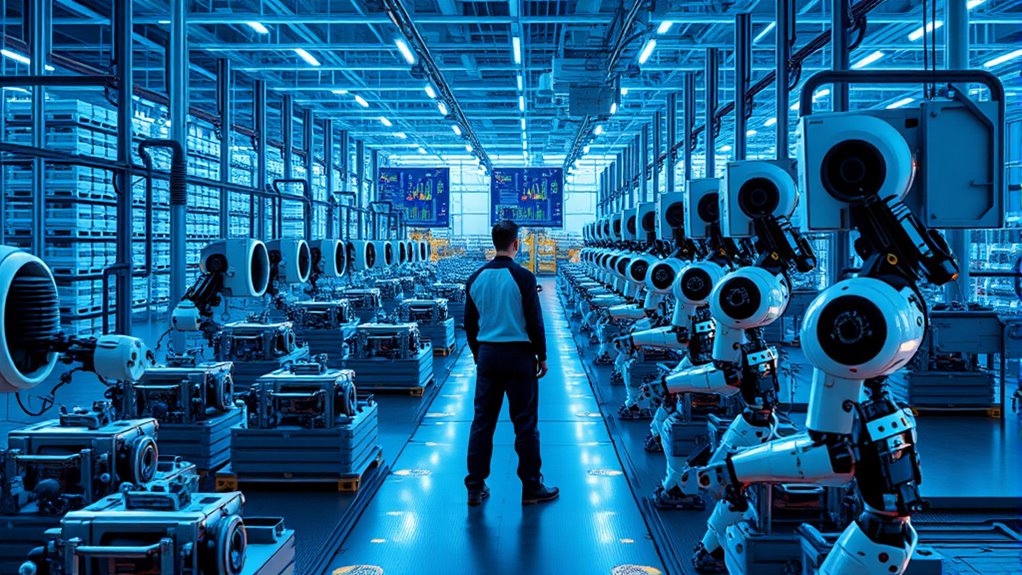In the future, robots are mainly owned by big tech firms and corporations rather than individuals, shifting control of automation and profit toward these powerful entities. As investments grow and innovation accelerates, ownership is becoming more concentrated among industry leaders in regions like Asia, the EU, and North America. This trend impacts economic power and societal structure, affecting jobs and wealth distribution. To understand how this shift could reshape your world, explore what lies ahead.
Key Takeaways
- Ownership is shifting from individuals to large tech firms and corporations due to increased automation and industrial robot deployment.
- Corporate control over robots enables economies of scale but raises concerns about wealth concentration and economic inequality.
- The rise of automation may displace millions of jobs, affecting ownership structures and income distribution across society.
- Regulatory frameworks and international standards are evolving to address liability, safety, and rights related to robot ownership.
- The future of capital in an automated economy will likely favor those owning robot infrastructure, intensifying debates on wealth redistribution.
The Changing Landscape of Robot Ownership

The landscape of robot ownership is rapidly evolving, driven by technological advancements and shifting market dynamics. About 17% of U.S. households owned at least one domestic robot in 2021, showing growing consumer interest. Service robots reached around 0.43 million units in 2023, with projections rising slightly by 2028, reflecting steady adoption in non-industrial settings. The prices for new service robots are increasing, from roughly USD 11.11K in 2023 to an estimated USD 12.71K in 2028, indicating higher complexity and value. Meanwhile, the humanoid robot market is expected to skyrocket from USD 2.98 billion in 2025 to USD 243.40 billion by 2035, with major corporations investing heavily. Ownership is shifting toward large tech firms, signaling a move from individual to corporate control in the robotics space. The global robot software market is projected to reach USD 120.5 billion by 2033, further shaping the future landscape of robot ownership and control. Additionally, the increased investment by major corporations suggests a trend toward corporate dominance in the robotics industry, potentially influencing global technological power dynamics.
Investment Trends Shaping the Robotics Market

Recent years have seen a remarkable surge in investment activity across the robotics sector, reflecting strong confidence in its growth potential. Venture capital investments topped $7 billion in October 2024, covering autonomous vehicles, humanoid robots, and agricultural automation. Major funding in 2025 focuses on emerging categories like surgical robotics and humanoid robots, driven by advances in AI and computer vision that expand application domains. Governments are also backing robotics, especially in defense projects involving autonomous systems. Technologies like AI, computer vision, tactile sensing, and large language models are fueling innovation. Sectors such as automotive manufacturing, surgical robotics, agriculture, and defense are benefiting from these investments. Furthermore, the Wall Decor industry is increasingly incorporating robotic and automated solutions for home and commercial spaces, highlighting the expanding influence of robotics in everyday life. A growing emphasis on regulatory hurdles and safety standards is shaping how these technologies are deployed in various sectors. The Gold IRA market projections show rapid growth, with the global robotics market expected to reach over $150 billion by 2030, reinforcing the sector’s promising future. Additionally, the ongoing development of robotic regulation frameworks aims to ensure safe integration of these technologies into society. As the technology behind robotics continues to evolve rapidly, it is likely to open up new opportunities and challenges for investors and policymakers alike.
Economic Benefits of Automation for Companies

Automation helps your company boost productivity by streamlining processes and enabling employees to focus on higher-value tasks. It also markedly cuts operational costs, sometimes by up to 90%, freeing resources for other investments. These efficiency gains directly contribute to your company’s growth and competitive edge in the market. Automation adoption rates across business functions are rising rapidly, further amplifying these benefits and ensuring sustained long-term advantages. Incorporating vibrational alignment techniques can also enhance employee well-being and overall organizational harmony, fostering a more resilient and innovative workplace environment. Additionally, understanding the side effects of juice detox can inform healthier lifestyle choices that support employee wellness initiatives.
Increased Productivity Gains
AI-driven automation enables significant productivity gains for companies, with an estimated potential of $4.4 trillion in growth by 2025. It speeds up task completion, allowing you to do more in less time. By reducing human error, automation improves output quality and efficiency, ensuring consistent results even with repetitive tasks. It also scales processes quickly, supporting growth without proportional increases in labor costs. Nearly all companies (94%) automate time-consuming tasks, and about 90% of knowledge workers report better job quality thanks to automation handling mundane work. Workforce productivity can improve by around 40% when AI is integrated into workflows. These gains lead to faster delivery, higher service levels, and a stronger competitive edge—making automation a powerful tool for maximizing economic benefits. High-quality equipment plays a crucial role in ensuring reliable and clear sound recordings, which can enhance the overall quality of automated content and processes. Additionally, the father-daughter bond exemplifies how strong relationships foster growth and trust, much like how effective automation builds efficiency and reliability in business operations.
Cost Reduction Strategies
By reducing labor and operational costs, automation helps companies boost their profitability and stay competitive. You can achieve significant savings through:
- Cutting payroll expenses by automating repetitive tasks and deploying chatbots for routine customer inquiries, which can yield ROI of 30%–200% in the first year. This automation can also improve indoor air quality by better humidity control and filtration, creating healthier work environments. Additionally, integrating natural materials and authentic decor elements can contribute to employee well-being and productivity. Incorporating vertical storage solutions can further maximize space efficiency in work areas.
- Minimizing inventory and supply chain costs with real-time management, automated procurement, and demand forecasting, reducing stockouts by 35% and lowering excess inventory.
- Enhancing operational efficiency by streamlining workflows, increasing speed and accuracy, and reducing fulfillment delays by up to 50%, all while lowering administrative costs through automated invoicing and approvals. Implementing tuning strategies can further optimize manufacturing processes and equipment performance.
- Automated processes also help detect inefficiencies early, enabling proactive adjustments that prevent costly errors and delays.
The Impact of Robots on Employment and Society

Robots are transforming the workforce in tangible ways, displacing millions of jobs and reshaping societal structures. Currently, about 14% of workers have experienced job displacement due to AI, with each additional robot per 1,000 workers reducing the employment-to-population ratio by 0.2 percentage points. In specific areas, adding a robot can cut six local jobs, totaling roughly 400,000 jobs lost in the U.S. so far. The impact hits non-White workers harder, decreasing their employment by 4.5 percentage points, and widens wage gaps, especially for men. Indirect effects also ripple through communities, reducing consumer spending and harming service sectors. While firms boost productivity, automation shifts roles from high-wage manufacturing to capital-intensive processes, often exacerbating existing inequalities and creating polarized job markets. Additionally, the adoption of automation in industries reliant on manual labor raises concerns about long-term employment stability for vulnerable populations. Moreover, the integration of AI security measures is crucial to ensure safe and reliable deployment of robots in societal settings. As automation becomes more pervasive, addressing technological safety is essential to prevent unintended consequences and protect public interests. Furthermore, understanding the ownership structures of automation technologies can influence how benefits are distributed across society. Developing clear frameworks around robot ownership can help address questions of accountability and equitable resource distribution.
Innovations Driving the Development of Humanoid Robots

You can see how advances in AI, like deep learning and large language models, are making humanoid robots better at understanding and interacting with humans. These innovations enable robots to adapt, recognize emotions, and communicate more naturally in various environments. As a result, human-like interaction design is transforming what robots can do and how they integrate into daily life. Emerging AI capabilities are allowing robots to perform complex social tasks and respond to nuanced human behaviors more effectively.
Advances in AI Capabilities
Recent breakthroughs in artificial intelligence are fueling rapid advancements in humanoid robot development, making them more capable and adaptable than ever before. These innovations are transforming how robots perform tasks and interact with their environment.
Here are three key AI advancements driving this progress:
- Deep learning integration enables robots to learn from vast data, improving adaptability.
- Reinforcement learning helps robots like Atlas continuously refine their balance and movement.
- Multimodal AI models allow real-time decision-making by processing multiple data types simultaneously.
Collaborations, such as Boston Dynamics with NVIDIA and Hyundai, accelerate these improvements. Technological advancements like real-time processing and advanced sensors also enhance robot autonomy and responsiveness. These innovations make humanoid robots more efficient across industries, shaping the future landscape of automation.
Human-like Interaction Design
Advancements in human-like interaction design are transforming humanoid robots into more intuitive and engaging partners. You’ll notice robots now use enhanced sensors to perceive emotions and gestures, creating more natural interactions. Natural language processing allows them to understand and respond to complex speech, while facial expression analysis helps interpret human feelings. Gestural recognition improves non-verbal communication, making exchanges feel more genuine. Voice tone interpretation ensures responses are appropriate and empathetic. These innovations, combined with advanced mobility like artificial muscles and precise actuators, enable fluid, human-like movements and dexterity. Robots can learn from interactions through cognitive AI, providing personalized responses and adapting over time. Together, these developments make humanoid robots better collaborators, capable of understanding and responding to human emotions with increasing sophistication.
Market Growth and Regional Dynamics in Robotics

The robotics market is experiencing rapid growth, with projections indicating it will reach approximately US$50.80 billion by 2025. This surge is driven by increased industrial robot installations, which hit a record value of US$16.5 billion. From 2025 to 2029, the market is expected to grow at an annual rate of 9.49%, and by 2034, it could surpass a CAGR of 16.6%.
Robotics market poised to reach $50.8 billion by 2025 with rapid growth driven by record industrial robot investments.
Regional dynamics play a crucial role:
- Asia-Pacific, led by Japan and South Korea, dominates adoption and innovation.
- The European Union is a key player in robotics development and deployment.
- North America invests heavily in AI and automation, shaping global trends.
Emerging markets like India and China are increasingly embracing robotics, influenced by government policies and technological progress.
Regulatory and Ethical Challenges in Robot Deployment

How can societies guarantee that the deployment of robots aligns with legal and ethical standards as technology advances? Developing international standards can create a consistent regulatory environment, enabling robots to operate smoothly across borders. Addressing liability issues is crucial; clear frameworks ensure accountability when accidents occur. The EU’s ongoing legislative overhaul aims to improve machinery regulations and AI governance, but compliance challenges remain for manufacturers, affecting competitiveness. Ethical concerns about autonomy, decision-making, human rights, and cross-border deployment demand strict guidelines. Assuring robots reflect human values, uphold responsibility, and gain public trust is vital. Balancing innovation with regulation helps prevent misuse, protect rights, and promote ethical integration of robots into society while navigating technical hurdles like safety, cybersecurity, and real-time adaptability.
The Role of Policy in Managing Automation’s Social Effects

As automation reshapes labor markets, policymakers play a vital role in shaping its social impacts. You need to understand that effective policies can help manage job displacement, reduce inequality, and foster social cohesion. Consider these key actions:
- Implement retraining programs to support workers moving into higher-skill roles.
- Develop active labor market policies that address job insecurity and promote employment.
- Enact redistribution measures like minimum income schemes to assist vulnerable populations.
Future Perspectives: Capital, Technology, and Society

Advancements in AI, blockchain, and energy technologies are transforming the landscape of capital ownership and societal organization. You’ll see more wealth concentrated among corporations and wealthy individuals owning robots and AI, while SMEs struggle with high automation costs. Public ownership models remain rare, and employee schemes are still experimental. Technology accelerates efficiency, with blockchain enabling transparent asset tracking and smart contracts. Semiconductor innovations boost AI and robotics performance, but cybersecurity becomes critical as digital assets grow. Energy tech—renewables and nuclear—power large-scale automation. These shifts reshape labor markets, favoring tech sectors and prompting upskilling efforts. Society wrestles with fairness, exploring ideas like UBI. Investment trends focus on AI, green tech, and healthcare, emphasizing diversification amid rapid change.
| Ownership Trends | Tech Advancements |
|---|---|
| Wealth concentrated in corporations | Blockchain for decentralization |
| SMEs face high automation costs | Semiconductor innovation |
| Rare public ownership models | AI, cloud, and edge computing |
| Venture capital fuels startups | Cybersecurity importance |
| Employee ownership remains rare | Renewable and nuclear energy tech |
Frequently Asked Questions
Who Primarily Owns Industrial Versus Service Robots Today?
Right now, you’ll find industrial robots mainly owned by manufacturing companies, who buy and operate them directly. Service robots, on the other hand, are often owned by individuals, businesses, or shared through subscription models. Industrial robots stay fixed in factories, while service robots are mobile and used across sectors like healthcare and domestic services. This ownership pattern reflects their distinct roles, functionalities, and operational environments today.
How Will Robot Ownership Influence Economic Inequality?
You should consider that robot ownership will considerably shape economic inequality. When capital owners control robots, they benefit most from automation, increasing wealth for the wealthy and leaving low-skilled workers behind. If you don’t own a stake in the robots, you risk job displacement and wage cuts. Widespread ownership of capital, like stock options or wealth redistribution, could help reduce inequality and give more people a fairer share of automation’s gains.
Are There Legal Frameworks for Robot Ownership Rights?
You’re wondering if there are legal frameworks granting ownership rights to robots. Right now, the law keeps robots as property—tools without rights—focused on regulating their safety and accountability. No legal system recognizes robots as owners or entities with rights. Instead, laws assign responsibility to humans—owners, manufacturers, or operators—ensuring accountability. While legislation evolves, granting robots ownership rights remains a distant, uncertain future, leaving you to navigate strict rules rather than rights.
How Does Robot Ownership Impact Innovation and Competition?
You see, owning robots boosts innovation by incentivizing research and enabling customization for specific needs. It gives you a competitive edge through cost savings, faster scaling, and market differentiation. As you adopt and control advanced automation, you push technological boundaries while increasing demand for skilled workers. This ownership accelerates industry growth, fosters new sectors, and enhances global competitiveness, but it can also widen gaps between different economies and smaller firms.
What Are Future Ownership Models in an Automated Economy?
So, you’re curious about future ownership models in an automated economy. Ironically, as robots and AI take over, ownership might become more decentralized, with blockchain and tokenization allowing you to share or trade assets easily. You could participate in cooperatives or public-private partnerships, enjoying flexible, shared access. Instead of owning a car, you might subscribe or hold shares in autonomous fleets, changing how you think about ownership altogether.
Conclusion
As you navigate the evolving world of robotics, remember it’s a river shaping the landscape of our economy and society. Ownership shifts like currents, driven by innovation and policy. Embracing this flow means steering wisely, balancing progress with ethical considerations. The future of automation isn’t just about machines—it’s about how you and society choose to ride these waves, shaping a world where technology and humanity move forward together in harmony.









